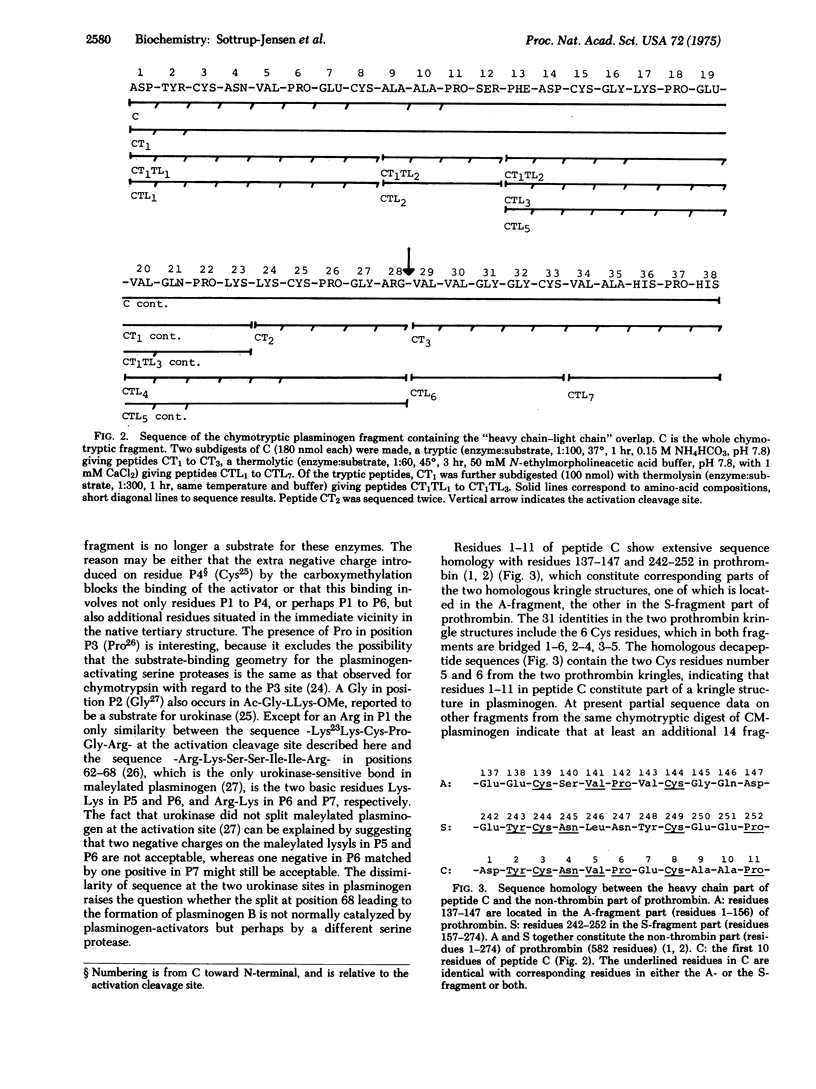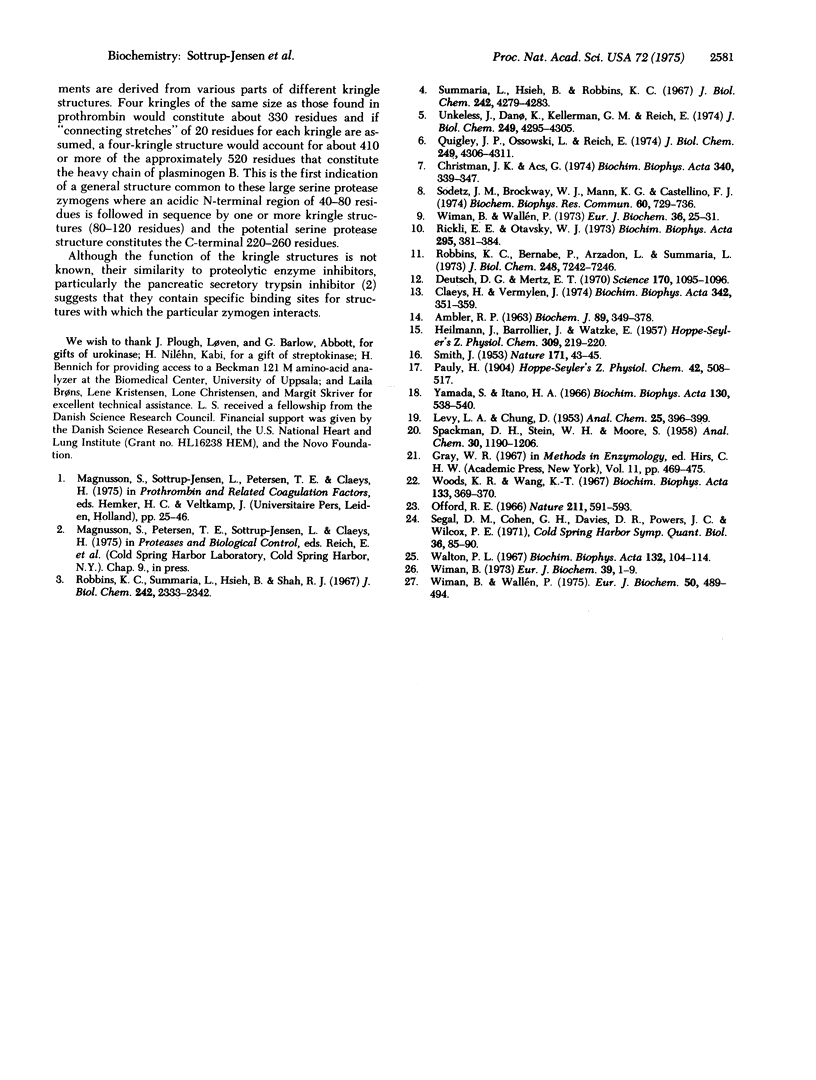Abstract
A 38-residue fragment is isolated from carboxymethylated plasminogen. Residues 29-38 have the same sequence as the amino-terminal end of the light chain of plasmin. The sequence 1-28 is therefore the sequence of the carboxyl-terminal end of the heavy chain and contains the specific sequence at which urokinase (EC 3.4.99.26) and other plasminogen-activating serine proteases split. Two of the five carboxymethyl-cysteine residues in the isolated fragment are situated close to the cleavage site and the fragment is not itself a substrate for plasminogen-activators. Residues 1-11 show extensive sequence homology with residues 137-147 and 242-252 in prothrombin, which are located in corresponding regions of the two internally homologous 83-residue structures in the non-thrombin part of the molecule, indicating that such structures may be a common feature of the non-protease part of the larger serine protease zymogens.
Full text
PDF




Selected References
These references are in PubMed. This may not be the complete list of references from this article.
- AMBLER R. P. THE AMINO ACID SEQUENCE OF PSEUDOMONAS CYTOCHROME C-551. Biochem J. 1963 Nov;89:349–378. doi: 10.1042/bj0890349. [DOI] [PMC free article] [PubMed] [Google Scholar]
- Christman J. K., Acs G. Purification and characterization of a cellular fibrinolytic factor associated with oncogenic transformation: the plasminogen activator from SV-40-transformed hamster cells. Biochim Biophys Acta. 1974 Mar 27;340(3):339–347. doi: 10.1016/0005-2787(74)90279-2. [DOI] [PubMed] [Google Scholar]
- Claeys H., Vermylen J. Physico-chemical and proenzyme properties of NH2-terminal glutamic acid and NH2-terminal lysine human plasminogen. Influence of 6-aminohexanoic acid. Biochim Biophys Acta. 1974 Apr 11;342(2):351–359. doi: 10.1016/0005-2795(74)90090-7. [DOI] [PubMed] [Google Scholar]
- Deutsch D. G., Mertz E. T. Plasminogen: purification from human plasma by affinity chromatography. Science. 1970 Dec 4;170(3962):1095–1096. doi: 10.1126/science.170.3962.1095. [DOI] [PubMed] [Google Scholar]
- HEILMANN J., BARROLLIER J., WATZKE E. Beitrag zur Aminosäurebestimmung auf Papierchromatogrammen. Hoppe Seylers Z Physiol Chem. 1957;309(4-6):219–220. [PubMed] [Google Scholar]
- Offord R. E. Electrophoretic mobilities of peptides on paper and their use in the determination of amide groups. Nature. 1966 Aug 6;211(5049):591–593. doi: 10.1038/211591a0. [DOI] [PubMed] [Google Scholar]
- Quigley J. P., Ossowski L., Reich E. Plasminogen, the serum proenzyme activated by factors from cells transformed by oncogenic viruses. J Biol Chem. 1974 Jul 10;249(13):4306–4311. [PubMed] [Google Scholar]
- Rickli E. E., Otavsky W. I. Release of an N-terminal peptide from human plasminogen during activation with urokinase. Biochim Biophys Acta. 1973 Jan 25;295(1):381–384. doi: 10.1016/0005-2795(73)90106-2. [DOI] [PubMed] [Google Scholar]
- Robbins K. C., Bernabe P., Arzadon L., Summaria L. NH2-terminal sequences of mammalian plasminogens and plasmin S-carboxymethyl heavy (A) and light (B) chain derivatives. A re-evaluation of the mechanism of activation of plasminogen. J Biol Chem. 1973 Oct 25;248(20):7242–7246. [PubMed] [Google Scholar]
- Robbins K. C., Summaria L., Hsieh B., Shah R. J. The peptide chains of human plasmin. Mechanism of activation of human plasminogen to plasmin. J Biol Chem. 1967 May 25;242(10):2333–2342. [PubMed] [Google Scholar]
- SMITH I. Colour reactions on paper chromatograms by a dipping technique. Nature. 1953 Jan 3;171(4340):43–44. doi: 10.1038/171043a0. [DOI] [PubMed] [Google Scholar]
- Segal D. M., Cohen C. H., Davies D. R., Powers J. C., Wilcox P. E. The stereochemistry of substrate binding to chymotrypsin A . Cold Spring Harb Symp Quant Biol. 1972;36:85–90. doi: 10.1101/sqb.1972.036.01.014. [DOI] [PubMed] [Google Scholar]
- Sodetz J. M., Brockway W. J., Mann K. G., Castellino F. J. The mechanism of activation of rabbit plasminogen by urokinase. Lack of a preactivation peptide. Biochem Biophys Res Commun. 1974 Sep 23;60(2):729–736. doi: 10.1016/0006-291x(74)90301-5. [DOI] [PubMed] [Google Scholar]
- Summaria L., Hsieh B., Robbins K. C. The specific mechanism of activation of human plasminogen to plasmin. J Biol Chem. 1967 Oct 10;242(19):4279–4283. [PubMed] [Google Scholar]
- Unkeless J., Dano K., Kellerman G. M., Reich E. Fibrinolysis associated with oncogenic transformation. Partial purification and characterization of the cell factor, a plasminogen activator. J Biol Chem. 1974 Jul 10;249(13):4295–4305. [PubMed] [Google Scholar]
- Walton P. L. The hydrolysis of alpha-N-acetylglycyl-l-lysine methyl ester by urokinase. Biochim Biophys Acta. 1967 Jan 11;132(1):104–114. doi: 10.1016/0005-2744(67)90196-9. [DOI] [PubMed] [Google Scholar]
- Wiman B. Primary structure of peptides released during activation of human plasminogen by urokinase. Eur J Biochem. 1973 Nov 1;39(1):1–9. doi: 10.1111/j.1432-1033.1973.tb03096.x. [DOI] [PubMed] [Google Scholar]
- Wiman B., Wallén P. Activation of human plasminogen by an insoluble derivative of urokinase. Structural changes of plasminogen in the course of activation to plasmin and demonstration of a possible intermediate compound. Eur J Biochem. 1973 Jul 2;36(1):25–31. doi: 10.1111/j.1432-1033.1973.tb02880.x. [DOI] [PubMed] [Google Scholar]
- Wiman B., Wallén P. Structural relationship between "glutamic acid" and "lysine" forms of human plasminogen and their interaction with the NH2-terminal activation peptide as studied by affinity chromatography. Eur J Biochem. 1975 Jan 15;50(3):489–494. doi: 10.1111/j.1432-1033.1975.tb09887.x. [DOI] [PubMed] [Google Scholar]
- Woods K. R., Wang K. T. Separation of dansyl-amino acids by polyamide layer chromatography. Biochim Biophys Acta. 1967 Feb 21;133(2):369–370. doi: 10.1016/0005-2795(67)90078-5. [DOI] [PubMed] [Google Scholar]
- Yamada S., Itano H. Phenanthrenequinone as an analytical reagent for arginine and other monosubstituted guanidines. Biochim Biophys Acta. 1966 Dec 28;130(2):538–540. doi: 10.1016/0304-4165(66)90256-x. [DOI] [PubMed] [Google Scholar]


